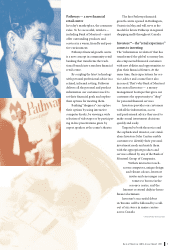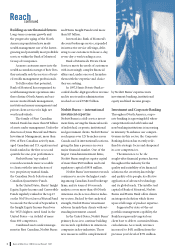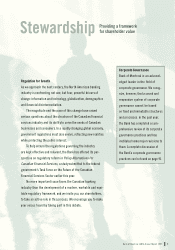Bank of Montreal 1997 Annual Report Download - page 19
Download and view the complete annual report
Please find page 19 of the 1997 Bank of Montreal annual report below. You can navigate through the pages in the report by either clicking on the pages listed below, or by using the keyword search tool below to find specific information within the annual report.
9796959493
20.6 23.1
14.3
22.2
26.1
9796959493
8.1
13.8
16.5
22.2
11.9
9796959493
14.1 15.4
14.9 17.0 17.1
9796959493
9.4 9.0
6.9 9.9
15.1
9796959493
60.0 64.3
62.0 63.4 64.4
196
547
153
112
181
539
186
150
9796
318 403
Shareholder Value
• Our five-year annualized ROI was 26.1%, up 3.9% versus our
1996 five-year ROI of 22.2%.
• Share price increased 50.1% compared to 36.3% in 1996.
• Dividends paid per share increased $0.19 in 1997 and $0.12
in 1996.
Profitability
• We achieved 17.1% ROE in 1997 which marks the eighth
consecutive year that we have exceeded our 14–15% objective.
• Our n et incom e growth measured 11.7% in 1997 compared t o
18.4% in 1996.
• ROE in 1997 exceeded the economic performance thresh old.
Earnings Growth
• We achieved 11.9% EPS growth in 1997, which marks the
eighth consecutive year of gro wth.
• Income growth was due to business volume gr owth and
higher Global Treasury and Investment and Corporate
Banking contributions.
• Earnings growth in 1997 and 1996 was above the minimum
objective of 10%.
Operating Group Review
• Total Bank net income growth of 11.7% was achieved through
diversified and differentiated business segments.
• Global Treasury Group and Investment and Corpo rate Banking
represented our highest grow th segments.
• Electroni c Financial Services’ net income decline of 7.4% was
largely due to continued investment in mbanx.
Revenue Growth
• Our revenue gro wth increased from a rate of 9.9% last year
to 15. 1% in 1997.
• Revenue grow th in 1997 was driven by business volume
growth, cash collections on impaired loans, and earnings on
bonds and equities of lesser develop ed countries as well as
strong other income growth from our fee-related businesses.
Productivity
• Our productivit y ratio increased 1.0% to 64.4% in 1997.
• The increase in the productivit y ratio was driven by an
increase in expense gr owth due to variable compensation
costs, investments for the future and other e xpenses
including a $75 million charge repr esenting accele rated
depreciation related to technolog y changes and costs associ-
ated with improving the efficiency of our credit pro cess.
Five-Year Return on Common
Shareholders’ Investment
(%)
More information can be found on page 21.
Return on Common Shareholders’ Equity
(%)
Objective (14
–
15%)
More information can be found on page 23.
Revenue Growth
(%)
More information can be found on page 24.
Expense-to-Revenue Ratio
(%)
More information can be found on page 28.
Net Income by Operating
Group
($ millions)
PCFS Harris
GTG I&CB
EFS
More information can be found
on page 30.
Fully Diluted Earnings Per Share Growth
(%)
Objective (10%)
More information can be found on page 22.
Bank of Montreal 180th Annual Report 199718
Financial Performance
9796959493
0.87
0.30
0.63
0.23 0.23
9796959493
54.8
20.5
29.9
15.7
7.6
9796959493
7.35 7.02
7.20 6.71 6.80
9796959493
35,409
53,336
41,194
60,796
74,034
30.3 35.1
29.8 35.8 35.6
Liquidity
• Our ratio of liquid assets to total assets was 35.6%, substan-
tially unchanged from 35.8% in 1996.
• Deposits are well dive rsified by customer, type, currency
and geography.
Capital Adequacy
• Our Ti er 1 ratio rose to 6. 80% in 1997 fro m 6.71% in 1996,
and in both years was well above regulatory requir ements.
• The increase was due to retained earnings growth and the
issuance of preferred shares in the se cond quarter.
• Our financial measure for asset quality is gross impaired
loansas a percentage of equity andallowance for credit losses.
This ratio in 1997 was 7.6% compared to 15.7% in 1996.
• The decrease was due to strong recoveries as well as a
reduced incidence of problem l oans.
Credit Rating
• Credit rating composite remained stable.
Asset Quality
• Our provision for credit losses as a percentage of average
loans and acceptances was 0.23%, unchanged from 1996.
Risk Management
• Our strong risk management culture drives a prudent and
professional approach to risk-taking.
• We manage risk with a view to balancing the risk-reward
relationship.
AA
-
• Credit Risk
• Position Risk
• Liquidity Risk
• Operational Risk
Provision for Credit Losses as a % of Average
Loans and Acceptances
Gross Impaired Loans and Acceptances as a %
of Equity and Allowance for Credit Losses
More information can be found on page 45.
Tier1Ratio
(%)
Tier1 Regulatory Requirement (4%)
More information can be found on page 48.
Cash Resources
($ millions)
Securities
Cash and Securities-to-Total Assets
(%)
More information can be found on page 50.
More information can be found on page 41.
Bank of Montreal 180th Annual Report 1997 19
Financial Condition
9796959493
20.6 23.1
14.3
22.2
26.1
9796959493
8.1 13.8
16.5 22.2 11.9
9796959493
14.1 15.4
14.9
17.0 17.1
9796959493
9.4 9.0
6.9
9.9
15.1
9796959493
60.0
64.3
62.0
63.4
64.4
Five-Year Return on Common
Shareholders’ Investment
(%)
• Our per formance was slightly below the Canadian
peer group average of 27.3%, and below the North
American peer group average of 29.0%.
Canadian Peer Group: Below Average
North American Peer Group: Below Average
Fully Diluted Earnings Per Share Growth
(%)
• Our EPS gr owth of 11.9% in 1997 was below the
Canadian and North American peer group averages
of 21.6% and 14.4% respectively.
Canadian Peer Group: Below Average
North American Peer Group: Below Average
Return on Common Shareholders’ Equity
(%)
• Our ROE in 1997 was below the Canadian peer group
average of 18.0% and above the North American peer
group average of 16.8%.
Canadian Peer Group: Below Average
North American Peer Group: Above Average
Revenue Growth
(%)
• Our per formance in 1997 was below the Canadian peer
group average of 18.0%, but higher than the North
American peer group average of 14.0%.
Canadian Peer Group: Below Average
North American Peer Group: Above Average
Expense-to-Revenue Ratio
(%)
• Our relativ e performance in 1997 was below the
Canadian peer group average of 63.0% and below the
North American peer group average of 61.3%.
Canadian Peer Group: Below Average
North American Peer Group: Below Average
Bank of Montreal
Canadian Peer Group Average
North American Peer Group Average
Relative Financial Performance
1997 199 6
(a)
Five-Year Average
Bank of 23 Bank of 23 Bank of 23
Montreal Bank Montreal Bank Montreal Bank
Performance Rank Average Performance Rank Average Performance Rank Average
Primary Financial Performance Measures
(%)
Five-year return on
common shareholders’
investment (ROI) 26.1 129.0 22.2 123.1 26.1
(c)
129.0
(c)
Fully diluted EPS growth 11.9 114.4 22.2 28.9 14.5 124.4
Return on ave rage
common shareholders’
equity (ROE) 17.1 416.8 17.0 415.7 15.7 116.3
Revenue growth 15.1 414.0 9.9 115.5 10.1 111.9
Expense-to-revenue ratio 64.4 161.3 63.4 162.5 62.8 162.5
Provision for credit
losses as a % of
average loans
and acceptances 0.23 20.60 0.23 20.56 0.45 40.69
Primary Financial Condition Measures
(%)
Gross impaired loans
and acceptances as
a % of equity
and allowance for
credit losses 7.65 16.76 15.71 19.28 7.65
(d)
16.76
(d)
Tier 1 ratio
(b)
6.35 17.61 6.26 17.60 6.35
(d)
17.61
(d)
Cash and securities-
to-total assets 35.6 230.0 35.8 229.6 35.6
(d)
230.0
(d)
Credit rating AA
-
2A+AA
-
2A+AA
-
(d)
2A+
(d)
The selection of the 23 largest banks is based on the siz e of their 1996 common shareholders’ equity: Bank
of Montreal, The Bank of Nova Sco tia, Canadian Imperial Bank of Commerce, Royal Bank of Canada,The Toronto-
Dominion Bank, Banc One Corp., BankAmerica Corporation, Bankers Trust N ew York Corporation, The Bank
of New York Company, Inc.,The Chase Manhattan Corp oration, Citicorp N.A., First Chicago NBD Corpor ation,
First Union Corporation, Flee t Financial Group, J.P.Mo rgan & Co. Inc., Keyc orp, Mellon Bank Corporatio n,
NationsBank Corporation, Nor west Corporation, PNC Bank Corp., SunTrust Banks, Inc., Wachovia Corporati on,
Wells Fargo & Company.
Note: Performance for the U.S. banks was based on the twelve-month pe riod ended September 30 to approximate
the Canadian bank fiscal year which ended on October 31.
(a) Reclassified to conform with 1997 presentation.
(b) U.S. basis
(c) Reflects five-year ROIfor the period ending October 31,1997.
(d) Condition ratios are as at October 31, 1997.
2Top Tie r
4Above Average/Average
1Below Average
Our ranking in the North American peer group in 1997 was top tier in three of our ten financial measures,
namely provision for credit l osses as a percentage of average loans and acceptances, cash and securities
-
to-total assets, and credit rating. Our ranking was above average in two categories, namely
ROE and
revenue
growth. We were below ave rage on five measures, namely five-year ROI, fully diluted EPS growth,
expense-to-revenueratio,grossimpairedloansandacceptancesasapercentageofequityand
allowance for credit losses, and the Tier 1 ratio.
We performed above average on the cr edit risk management measure, namely provision for credit
losses as a perce ntage of av erage loans and accep tances, in e ach of the p ast five y ears. We perfor med
below average on revenue gro wth and expense-to-reve nue ratio in three of the past five years.
Our ranking relative to the North American pe er group on a five-year average basis was top tier in
two and above average in one of our ten financial measures, namely cash and securities-to-total assets,
creditrating,andprovisionforcreditlossesasapercentageofaverageloansandacceptances,res-
pectively.We were below average on sevenmeasures, namelyfive-year ROI, EPS growth,ROE, revenue
growth,e xpense-to-revenueratio, gross impairedloans and acceptancesas a percentage of equity
and allowance for credit losses, and the Tier 1 ratio.
North American Peer Group Comparison
Performance
at a Glance
Financial Condition Measures
Performance
Where to find more information
Peer Group Information
Relative Performance
Financial Performance Measures
Section title – sections organized
by primary financial measure
Highlights of results
Financial Goals and Measures Our financial objective is to maximize long-term
shareholder value by achieving consistently superior (above average) earnings growth
and return on common shareholders’ equity while maintaining an appropriate divi-
dend yield. We have and will continue to achieve this by adhering to our strategy to earn,
grow and invest all at the same time; to advance management sciences; and to
diversify lines of business.
To assess our financial performance and condition, we continuously monitor a set
of ten financial measures which balance profitability and prudential concerns.
Our goal is to achieve consistently superior performance relative to our peer groups,
thereby achieving top tier (in the top quartile) return for our shareholders over the
long term. The graphs and statistics on the following pages assess our performance
on these “primary” measures in comparison to the six largest chartered banks in
Canada (the Canadian peer group) and 23 of the largest banks in North America (the
North American peer group). Top tier means being in the top two of the Canadian
peer group and in the top six of the North American peer group. Definitions of the
ten financial measures are disclosed in the Management Analysis of Operations
section of the 1997 Annual Report beginning on page 20.
Bank of Montreal
























